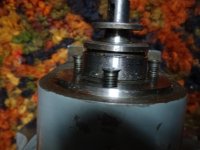Randalthor
Cast Iron
- Joined
- Mar 7, 2018
- Location
- Kansas City
Pretty simple question I think, but couldn't find the answer in the recent thread, "Universal Dividing Head" or a search of the archives.
I recently aquired a Hardinge universal dividing head. The question I have is how to engage the spiral drive on the dividing head. In other words, when I turn the manual handle of the dividing head to turn the spindle, the input power shaft used when cutting spiral gears doesn't move. It's like it's in "neutral". It's like the manual input shaft and the power input shaft are disengaged.
I would think these two shafts are connected inside the dividing head, perhaps with some sliding gear which locks and disengages the two inputs? I don't know how to lock or unlock them.
Here is a pick of the input power shaft.

I recently aquired a Hardinge universal dividing head. The question I have is how to engage the spiral drive on the dividing head. In other words, when I turn the manual handle of the dividing head to turn the spindle, the input power shaft used when cutting spiral gears doesn't move. It's like it's in "neutral". It's like the manual input shaft and the power input shaft are disengaged.
I would think these two shafts are connected inside the dividing head, perhaps with some sliding gear which locks and disengages the two inputs? I don't know how to lock or unlock them.
Here is a pick of the input power shaft.






